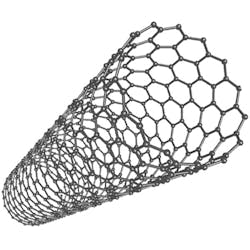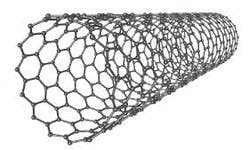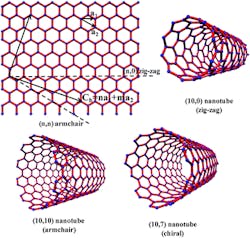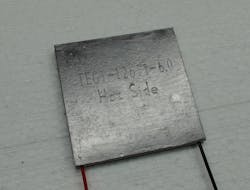Study Reveals Organic Semiconductors’ Overwhelming Thermoelectric Efficiency
Currently, CNT structures are heavily researched for new-age electronics because of their tunable optical and electronic properties; flexibility that allows different form factors; and cost-effective synthesis. But many more capabilities have yet to be explored, such as their ability to turn waste heat into electricity.
In a recent study led by the National Renewable Energy Lab (NREL), scientists were able to use highly-controlled methods to perform in-depth analysis of thermoelectric capabilities of single-walled âCarbon-nanotubes (CNTs, fig. 1). The results of the study point to never-before-seen benefits of replacing inorganic thermoelectric semiconductors with organic ones. Through careful analysis, they assessed differences in CNT electronic bandgaps/tube diameters, thermal conductance values, and doping levels/charge-carrier densities.
The team hopes that their report, published in Nature Energy will encourage research to secure organic semiconductors as high-efficiency voltage supplies in a wide range of heat-regenerative systems. The new-found increase in thermoelectric performance may prove to be a big leap in sustainable and renewable energy, especially since CNTs are inexpensive and easy to produce.
Overcoming obstacles for a controlled experiment
Semiconductors exhibit better thermoelectric properties than metals, so separating semiconducting CNTs (s-CNTs) from metallic CNTs (m-CNTs) is critical to the experiment. Using a new process invented by a senior scientist and manager of NREL's Spectroscopy and Photoscience group, the team used fluorene-based polymers that bond solely to s-CNTs to extract s-CNTs from a poly-disperse soot mixture.
In addition, the scientists could produce samples with various bandgaps by introducing three polymers that selectively bind to various s-CNT diameters and chirality structures (see image 2). Since the tube's structure is spacially constrained, these characteristics affect the electronic bandgap. The samples were washed with toluene to remove excess polymers, and deposited onto glass sheets to create thin, semiconductor films with tunable characteristics.
Doping
The scientists then introduced a controlled method of doping to test the correlation of electrical conductivity and thermoelectric performance. By introducing different levels of doping concentrations, they tested various bandgaps and charge-carrier densities across the samples. The team found that the sample with intermediate-sized diameter performed best under all doping conditions.
The ability to test a controlled doping process on uniform organic materials with known characteristics also led to a surprising discovery: not only did doping increase the material’s electrical conductivity, but it also decreased its thermal conductivity. This has not so easily been achieved in inorganic thermoelectrics, and is expected to lead to higher control of thermoelectric performance in materials.
Why is low thermal conductivity and high electrical conductivity important?
A material’s intrinsic ability to generate a voltage potential over a temperature gradient is represented by its Seebeck coefficient usually expressed in µV/Kelvin. This occurs as thermally-induced charge carriers like electrons migrate from high to low heat, causing a voltage potential across the material. The Seebeck coefficient is also known as the thermopower.
But the overall performance of a thermoelectric doesn’t depend solely on its thermopower. While scientists can use it to calculate the thermoelectric performance, or efficiency, of a material, they also need to know electrical conductivity (σ) and thermal conductivity (κ). As seen in the equation below, a material will have a high overall thermoelectric performance (zT) over a temperature range if its electrical conductivity is relatively larger than its low thermal conductivity:
zT= σ2 T S / κ,
Therefore, the ability to use the same doping process to increase σ and decrease κ is a great breakthrough in creating efficient thermoelectric materials.
Conclusion:
Using a novel experimental technique developed in Prof. Barry Zink’s group at the University of Denver, the team tested the thermoelectric properties of one of the samples under four different temperature gradients over a wide temperature range. They found that Seebeck coefficient increases with temperature, as does the electrical conductivity, which is characteristic to semiconductors. In addition, they found that doping decreased the thermal conductivity, and that temperature had no effect on it. The rise in S and σ and constant κ over an increasing temperature gradient resulted in a higher thermoelectric performance at high temperatures!
The results showed a 2.5 enhancement of the value for zT at 300 Kelvin (80ËF), which is highest efficiency in organic semiconductors. In addition, the scientists found that their semiconductive films could withstand temperatures as high as 500 K, suggesting that these materials could be used for low-grade waste heat conversion.
Overall, the CNT-polymer films had a large thermoelectric power factor of 340 µWm-1 K-2. This is higher than most contemporary organic thermoelectrics and sets a record for carbon nanotube thermoelectrics.
How are Thermoelectrics Used?
The Seebeck effect occurs as thermally-induced charge carriers like electrons migrate from high to low heat, causing a voltage potential across the material. A thermoelectric device usually contains two adjacent n-type and p-type thermoelectric semiconductors. When attached to a heat source and a heat sink (a low-temperature reservoir), electrons and holes in the n-type and p-type leg move toward the heat sink to create a voltage potential that can drive a current when attached to a circuit.
Most materials exhibit the Seebeck effect at some level, but semiconductors can be doped for a higher Seebeck effect. Also, opposite to the reaction of metals, semiconductors see an increase in electrical conductivity with a rise in temperature so that they can drive a current when attached to a circuit. In addition, their lower heat conductivity helps maintain a temperature gradient.
The NREL researchers, along with Professor Yong-Hyun Kim's group at the Korea Advanced Institute of Science and Technology, and Professor Barry Zink's group at the University of Denver, were able to produce surprising data regarding the thermoelectric performance of the organic semiconductors, with doping conditions that had inverse effects on the electrical and thermal conductivities. The results proved very different from the performance of inorganic thermoelectrics, such as lead telluride, selenium tin, and bismuth telluride.
About the Author
Leah Scully
Associate Content Producer
Leah Scully is a graduate of The College of New Jersey. She has a BS degree in Biomedical Engineering with a mechanical specialization. Leah is responsible for Machine Design’s news items that cover industry trends, research, and applied science and engineering, along with product galleries. Visit her on Facebook, or view her profile on LinkedIn.



